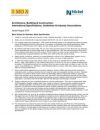Stainless Steel Specifications & Guidelines
Properly specified stainless steel can last the life of a building or structure with only minimal maintenance cleaning. Unfortunately, many project specifications are incomplete which can lead to unexpected failures.
Properly specified stainless steel can last the life of a building or structure with only minimal maintenance cleaning. Unfortunately, many project specifications are incomplete, which can lead to miscommunications about requirements or even unexpected corrosion staining failures. This section of our website focuses on fundamental specification issues and the importance of using internationally recognized stainless steel specifications and guidelines. Please see Stainless Selection for guidance on selecting an appropriate stainless steel and finish to meet corrosion performance requirements.
International Specifications, Guidelines & Industry Associations
International list of widely used stainless steel product, material and welding standard specifications, structural design resources, basic rules and resource sites. Stainless steel industry association contacts are provided to assist with country specific specifications
Fundamental Rules
Complete specifications are critical for communicating requirements. They can always be tightened and still be legally binding, but not relaxed. These are the most important rules, others can be found in our list.
1. A standard (ASTM, EN, JIS, etc.) or guideline from an internationally recognized standard setting body should always be used to specify the alloy, mechanical and physical properties, tolerances (aesthetic, flatness and dimensional) and other requirements.
2. Industry and professional association brochures are not standards and are therefore not legally binding. Text can be extracted and used to create a project specification but they should not be referenced like standards.
3. Suppliers should be required to provide the mill certifications for all of the stainless steel and, if applicable, the weld filler metal used. This helps to ensure compliance and provides material traceability.
4. A legally binding alloy designation such as UNS or EN number should be used to designate the specific alloy chemistry. No stainless steel AISI numbers (304, 316, etc.) have been issued for about 40 years and they are too general. Identifiers like “18-8” are even less precise and that can lead to problems. If there is a common name like Type 316L, use both it and the UNS or EN number (i.e. 316L /UNS S31603 or EN 1.4404). There is further guidance in our Stainless Steel Selection pages.
5. Unlike mill and polished finishes (i.e. No. 3, 4, 7, 8) which are described in industry standards, many aesthetic finishes are not and must be described and quantified as much as possible in project specifications. Read more about Finish Specification.
6. Minimum, maximum or thickness ranges should be specified in inches or mm. Stainless steel “gauges” are not defined by industry standards. Without a specific thickness, you have no legal protection.
7. “L” after AISI numbers mean lower carbon content. It only needs to be specified when an austenitic stainless steel (i.e. 304L (UNS S30403) or 316L (UNS S31603)) that is 0.125 inch (3.175 mm) or greater in thickness will be welded. Other than the welded area, carbon has no effect on corrosion performance.
8. Sulfur content affects both the appearance and corrosion resistance of austenitic stainless steels. Sheet, strip and plate can be specified as low sulfur. Bar, tube and pipe will have higher sulfur levels and should be chemically passivated to remove surface sulfides after fabrication. See the ASTM A240 notes.
9. Pickling, electropolishing and/or grinding is required to restore corrosion resistance after welding or when there is deeply embedded carbon steel from fabrication. Specifiers should require compliance with ASTM A380 or a comparable international standard. Read about Cleaning and Installation and about fabrication of Austenitic and Duplex stainless steels.
10. If the stainless steel has a higher sulfur level, if iron contamination during fabrication is likely, or if your surface finish is rough, you should require chemical passivation after the final fabrication and finishing. If you are using ASTM standards, then A967 is the correct specification.


